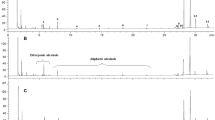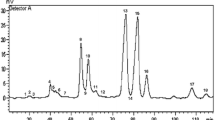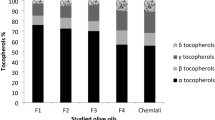Abstract
In this study, the quality characteristics, i.e., the acidity and acylglycerols, of currently produced Mallorcan oil was analyzed by titration and gas-chromatographic technique, respectively, in approximately 400 samples of monovarietal olive oil made from three genetic varieties (Arbequina, Empeltre, and Picual) on the island of Mallorca during the 2003/2004 and 2005/2006 seasons, and the differences in the compositions were discussed. Composition analysis showed that free fatty acids (FFAs) and DAGs were produced mainly by hydrolysis of triacylglycerols (TAGs). Fruit storage tests revealed that hydrolysis occurred during storage of olive fruits. The DAG content was higher in oil with higher acidity, but the maximal DAG content was only about 10 with 30% acidity, and the primary isomer found in Mallorcan oil was 1,3-DAG. However, the chiral-chromatographic study on the ratio of sn-1,2-DAG to the sum of sn-1,2-DAG and sn-2,3-DAG in a slightly hydrolyzed oil sample indicated that Empeltre and Picual fruits possess an sn-3-enantioselective lipase that leads to accumulation of sn-1,2-DAG. In currently produced Mallorcan oil, significant isomerization appears to occur and hydrolysis of the resulting 1,3-DAGs seems to lessen DAG accumulation.
Similar content being viewed by others
Explore related subjects
Discover the latest articles, news and stories from top researchers in related subjects.Avoid common mistakes on your manuscript.
Introduction
Olive oil is more acidic and has a higher DAG count compared to other plant oils [1]. DAGs in olive oil are generated during biosynthesis and hydrolysis of TAGs. The DAG content is relatively high in acidic oils, suggesting that hydrolysis is the primary cause of DAG accumulation [2, 3]. Hydrolysis not only occurs during fruit storage prior to oil extraction, but also takes place even after the oil has been extracted [4, 5]. In addition, the DAG isomer ratio in olive oil varies over time. The ratio of 1,2-DAG is high in fresh oil, while the ratio of 1,3-DAG increases when fruits are stored or damaged [6, 7]. Therefore, total DAG and 1,2-DAG content may be used together as an index of olive oil quality [8]. Recently, extra-virgin and virgin grade oils were reported to have total DAG and 1,2-DAG contents ranging from 1.0–3.2 to 0.1–2.6%, respectively, while Lampante and Reffino grade oils had total DAG and 1,2-DAG ranging from 5–6 to 1.6–1.7%, respectively [5, 6, 9]. Olive oil previously produced on Mallorca Island was characterized by its high acidity, unique flavor, and DAG content of 20 mol% (predicted to be approximately 20 wt%); olive oil with 3–30% acidity has been reported [10]. However, the olive oil variety and harvest/extraction systems have recently changed and the current quality criteria favor oils that are less acidic [11].
In the present study, the acidity and acylglycerol content in olive oil produced on Mallorca (Spain) during the three seasons from 2003/2004 to 2005/2006 were analyzed to identify the quality characteristics of currently produced Mallorcan olive oil.
Experimental Procedures
Olive Oil Preparation
Approximately 400 samples of monovarietal olive oil produced from three varieties (Arbequina, Empeltre, and Picual) on Mallorca during the three seasons from 2003/2004 to 2005/2006 were analyzed. To investigate the profile of hydrolysate, about 70 high-acidic oils, that were expected to be more hydrolyzed, were collected in the 2003/2004 and 2004/2005 seasons. In the 2005/2006 season, 324 oil samples were collected from Mallorca randomly to identify the quality characteristics, including acidity of current Mallorcan olive oil.
Fruit Storage Test
To determine the influence of the duration of the storage period on olive oil quality characteristics, portions of Arbequina olive fruits harvested in the 2004/2005 and 2005/2006 seasons were stored outdoors in approximately 1 m3 baskets for 1–30 days prior to extraction.
Acidity
The acidity was measured by titration, and presented as oleic acid% according to EU commission regulation No 2568/91 [12].
Oil Composition
Oil samples of approximately 20 mg were converted into trimethylsilylated derivatives, and were analyzed using an Agilent 6890 gas–liquid chromatograph with a flame-ionized detector (Agilent Technologies Inc., Santa Clara, CA) [13]. The weight percentages of each acylglycerol relative to the sum of the acylglycerols, P(MAG), P(DAG), and P(TAG), were determined from the peak area ratio corresponding to each acylglycerols based on the response factors of analytical grade glycerol monooleate, glycerol dioleate and glycerol trioleate. Oil composition was calculated from the acidity and acylglycerol ratio using Eqs. (1)–(4). P(X) represents the weight percentage of acylglycerol X relative to the sum of the acylglycerols.
Enantiomer Ratio
The enantiomer ratios were analyzed according to the method of Itabashi et al. [14]. DAG-dinitrophenyl urethane (DNPU) derivatives were prepared by combining approximately 20 mg oil with 0.5 ml dinitrophenyl isocyanate (DNPI) reagent (toluene solution containing 10 mg of DNPI and 0.05 ml of pyridine), followed by mixing at room temperature for 3 h. The reaction was stopped by addition of 0.5 ml methanol. The reactants were separated on a thin-layer chromatography (TLC) plate (silica-gel, hexane:dichloroethane:ethanol = 40:10:3 v/v/v) and the DAG-DNPU fraction (Rf = 0.5–0.6) was obtained.
The DAG-DNPU fraction was further separated using TLC (silica-gel, chloroform:acetone = 99:1 v/v). The sn-1,2(2,3)-DAG-DNPU fraction (Rf = 0.25) was applied to a chiral column (AK-03, 4.6 × 250 mm, YMC Co. Ltd., Kyoto, Japan)-equipped HPLC (Elite, Hitachi High-Technologies Corp., Tokyo Japan), using a detection wavelength of 254 nm. Separation was conducted at 10°C with hexane:dichloroethane:ethanol (40:10:1 v/v/v) mobile phase of 1 ml/min. In this study, the enantiomers of 1,2-DAG are described as sn-1,2-DAG and sn-2,3-DAG, and their sum is described as 1,2-DAG.
Mass Balance in Fatty Acyl (FA) Groups
The mass balances of FA groups between each sample and the oil consisting of pure TAG were evaluated using Eqs. (5) and (6) to determine if all the FFA and partial acylglycerols in a sample were generated by the hydrolysis of a pure TAG. The total number of FA groups present in an oil sample consisting of FFA and partial acylglycerol [see Eq. (5)] were plotted against the reduction of the number of FA groups remaining in the TAG molecule (deviation from the FA mass present in the theoretical pure TAG) as calculated using Eq. (6):
where d[FA group in FFA, MAG, DAG] represents the sum of FA groups in FFA, MAG, and DAG contained in the sample per unit weight. [X] represents the molar concentration of the component X. d[FA group in TAG] represents the difference in the sum of FA groups per unit weight between the theoretical pure TAG and the actual TAG content in a sample. Theoretical pure TAG was defined by assuming all of the FA mass in a sample had been incorporated to TAG molecule.
Statistical Analysis
At first, the Spearman rank correlation coefficient was used to assess the influence of acidity on partial acylglycerols content. We considered a correlation coefficient of greater than 0.7 with a statistical significance of p < 0.05 to be a strong correlation. Regression analysis was further carried out for acylglycerols showing strong correlation. Because logarithmic transformation of FFA and (1,3-DAG − 2) showed a good linear relationship (Pearson’s correlation coefficient >0.9), the difference in the correlation between acidity and 1,3-DAG among the genetical varieties (GVs) and the harvest seasons (HSs) was tested by the linear regression analysis between Log (FFA) and Log (1,3-DAG − 2). The regression line was expressed as intercept and slope with 95% confidence intervals (CI). Two-way analysis of variance (ANOVA) with Tukey correction for statistical multiplicity was used to identify the differences in oil composition. The effect of GVs, the effect of HSs and their interaction were estimated in the linear model. The level of significance was set at p = 0.05.
Results and Discussion
To investigate the characteristics of the hydrolytic profile of Mallorcan oil, the correlation between acidity, an indicator of the progress of acylglycerol hydrolysis, and acylglycerol content in the olive oil was determined. Results are shown in Fig. 1. Acidity was higher in the Empeltre variety (p < 0.01), indicating the lipase activity in Empeltre fruit might be higher than that of other varieties. A strong correlation was found between acidity and 1,3-DAG content (Spearman’s r = 0.96). The total DAG content was higher in oils with high acidity, and the maximal DAG content of all samples tested was 10.1% with 30% acidity (Fig. 1b). In contrast, very little correlations were observed between acidity and the MAG or 1,2-DAG content (Spearman’s r = 0.20, 0.22, respectively, Fig. 1a, c). We next investigated if the correlation between acidity and 1,3-DAG content is affected by GV or HS to obtain further insights on the DAG production mechanism. The correlation between acidity and 1,3-DAG content was evaluated for different GV and different HS by a regression analysis. The results are shown in Table 1. Although there was a slight difference in the intercept of Picual variety, the correlation between acidity and 1,3-DAG content was almost the same among the GV and the HS. These results indicate that acylglycerol composition may have been changed by the process of hydrolysis after harvesting.
To confirm that the hydrolysis of TAG is the source of DAGs, the quantitative relationship between hydrolyzed TAGs and the subsequently produced FFAs and partial acylglycerols were analyzed by evaluating the mass balance of FA groups. If the amount of the hydrolysates (FFA, MAG and DAG) matches the reduction of TAG content, these hydrolysates are likely to have originated from TAG hydrolysis in the olive fruits. Figure 2 shows the mass balance. The reduction in TAGs is matched to the increase in FFA and partial acylglycerols. This result suggests that the acidity and partially hydrolyzed acylglycerols in olive oil result mainly from TAG hydrolysis and not from biosynthesis or degradation of phospholipids.
Data of the samples from the fruit storage test of the Arbequina variety are also shown in Figs. 1, 2, 3 with diamond plots. During the storage test, the acidity and DAG content increased with time suggesting that this change is apparently due to TAG hydrolysis. The correlation between the acidity and 1,3-DAG content observed in samples for storage test representing the process of hydrolysis of a same olive fruit sample was not significantly different when compared with other oil samples (Fig. 1). This result suggested that hydrolysis during the fruit storage had a major impact on the composition of olive oil. These data further support that the partial glycerides in the sample are from TAG hydrolysis.
Changes in the geometric isomer ratio of DAG are shown in Fig. 3. The DAGs in low-acidity oils were mainly in the isoform of 1,2-DAGs (the sum of sn-1,2-DAGs and sn-2,3-DAGs), thus the product of the first step of hydrolysis of Mallorcan olive fruits may be 1,2-DAGs. However, according to the results shown in Table 1, the change in composition of Mallorcan olive oil seems to occur through the production of 1,3-DAG. The ratio of 1,2-DAG to total DAG decreased with increasing acidity, and reached approximately 30%, which is the thermodynamic equilibrium when acidity is 2% or higher. The increase in 1,3-DAG did not exceed the thermodynamic equilibrium, suggesting that 1,3-DAGs were produced by isomerization of 1,2-DAGs and were not the direct product of hydrolysis. In Mallorcan olive oil, isomerization of DAGs may have occurred at a much faster rate than hydrolysis, such that only 1,3-DAGs appeared to increase. Reportedly, in Mission variety olive fruits harvested on Shodoshima Island (Japan), the enantioselective hydrolysis of fatty acid at the sn-3 position leads to the accumulation of sn-1,2-DAGs suggesting that isomerization is suppressed [15]. In contrast, isomerization in Mallorcan olive fruits appears to be markedly higher than that in Mission fruits. Therefore, it is considered that additional hydrolysis of the resulting 1,3-DAGs to MAGs and FFAs leads to a lower DAG accumulation (<10%) despite the elevated acidity. The cause of apparently different isomerization rates among GV is unknown. The remarkably rapid isomerization may have been due not only to GV differences, but also to exposure to high temperatures, e.g. fermentation heat during storage or in the process of oil production.
The ratio of DAG enantiomers was analyzed for 10–11 samples randomly selected from each genetic variety used in the previous experiments and is shown in Fig. 4. In the Picual and Empeltre varieties, the ratio of sn-1,2-DAG was high during the early stages of hydrolysis, and the ratios of the two enantiomers approached thermodynamic equilibrium as the acidity increased. In the Arbequina variety, the two enantiomers were present in equal amounts even in samples with low acidity. These results indicate that the lipases of the Picual and Empeltre varieties have enantioselectivity for the sn-3 position, as does the lipase of the Mission variety [15], but the lipase of the Arbequina variety appears to have low enantioselectivity. Enantioselectivity for the sn-3 position of lipase may lead sn-1,2-DAG accumulation under the slow isomerization condition because sn-1,2-DAG is not a favorable substrate for lipase. Thus, in the Arbequina variety, DAG accumulation may have been suppressed to the level equivalent to that of other varieties even if isomerization was slow because the hydrolysis of sn-1,2-DAG by the lipase had less enantioselectivity. In 1985, Barceló et al. [10] reported that the DAG content of Mallorcan olive oil was approximately 20 mol%. The Empeltre variety, which is one of the most important varieties of Mallorcan olives, has an enantioselective lipase and produces oil with high-acidity. Our results indicate that when fruit of the Empeltre variety is stored under conditions that suppress isomerization, such as low temperature, DAGs may accumulate to high levels, as reported by Barceló et al. [10].
The DAG content for the 324 oil samples randomly collected from Mallorca during the 2005/2006 season are summarized in Table 2. The acidity of most of the oils from the Arbequina and Picual varieties were less than two, thereby meeting the acidity criteria for virgin grade oil, although many highly acidic oils were obtained from the Empeltre variety. The total DAG and 1,2-DAG contents were similar to those described in previous reports [5, 6, 9], confirming that the quality of the olive oil, with regard to acidity and DAG content, produced on Mallorca was equivalent to that of oils produced in other regions.
Abbreviations
- DAG:
-
Diacylglycerol
- TAG:
-
Triacylglycerol
- MAG:
-
Monoacylglycerol
- FFA:
-
Free fatty acid
- GV:
-
Genetic variety
- HS:
-
Harvest season
References
D’Alonzo RP, Kozarek WJ, Wade RL (1982) Glyceride composition of processed fats and oils as determined by glass capillary gas chromatography. J Am Oil Chem Soc 59:292–295
Salas JJ, Sanchez J, Ramli US, Manaf AM, Williams M, Harwood JL (2000) Biochemistry of lipid metabolism in olive and other oil fruits. Prog Lipid Res 39:151–180
Sanchez J, Harwood JL (2002) Biosynthesis of triacylglycerols and volatiles in olives. Eur J Lipid Sci Technol 104:564–573
Pereira JA, Casal S, Bento A, Oliveria MBPP (2002) Influence of olive storage period on oil quality of three Portuguese cultivars of Oleo europea, Cobrancosa, Madural and Verdeal Transmontana. J Agric Food Chem 50:6335–6340
Spyros A, Phillippidis A, Dias P (2004) Kinetics of diglyceride formation and isomerization in virgin olive oils by employing 31PNMR spectroscopy. Formulation of a quantitative measure to assess olive oil storage history. J Agric Food Chem 52:157–164
Fronimaki P, Spyros A, Christophoridou S, Dais P (2002) Determination of the diglyceride content in Greek virgin olive oil and some commercial olive oils by employing 31P NMR spectroscopy. J Agric Food Chem 50:2207–2213
Perez-Camino MC, Moreda W, Cert A (2001) Effect of olive fruit quality and oil storage practices on the diacylglycerol content of virgin olive oils. J Agric Food Chem 49:699–704
Catalano M, De Leonardis T, Comes S (1994) Diacylglycerols in the evaluation of virgin olive oil quality. Grasas y Aceites 45:380–384
Gomes T, Caponio F, Delcuratolo D (2003) Non-conventional parameters for quality evaluation of refined oils with special reference to commercial class olive oil. Food Chem 83:403–408
Barceló Mairata I, Barceló Mairata F (1985) Analisis de la Composicion Lipidica del Aceite de Oliva Virgen de Mallorca. Grasas y Aceites 36:269–273
Angerosa F, Campestre C, Giansante L (2006) Analysis and authentication. In: Boskou D (ed) Olive oil: chemistry and technology, 2nd edn. AOCS press, Chanpagne
Commission Regulation (EEC) No 2568/91 of 11 July 1991 on the characteristics of olive oil and olive-residue oil and on the relevant methods of analysis. Off J Eur Union L 248:1–83
Shimizu M, Moriwaki J, Nishide T, Nakajima Y (2004) Thermal diacylglycerol and triacylglycerol oils during deep-frying. J Am Oil Chem Soc 81:571–576
Itabashi Y, Kukis A, Marai L, Takagi T (1990) HPLC resolution of diacylglycerol moieties of natural triacylglycerol on a chiral phase consisting of bonded (R)-(+)-1-(1-Naphthyl) ethylamine. J Lipid Res 31:1711–1717
Shimizu M, Kudo N, Nakajima Y, Matsuo N, Katsuragi Y, Tokimitsu I, Barceló F (2008) Effect of lipase activity and specificity on the DAG content of olive oil from the Shodoshima-produced olive fruits. J Am Oil Chem Soc 85:629–633
Acknowledgments
We would like to thank Oli-Caimari in Palma of Mallorca (Spain) for the donation of the olive oil samples. We also acknowledge collaboration with the University of the Balearic Islands (“Fundació Universitat Empresa de Les Illes Balears, FUEIB”).
Author information
Authors and Affiliations
Corresponding author
About this article
Cite this article
Shimizu, M., Kudo, N., Nakajima, Y. et al. Acidity and DAG Content of Olive Oils Recently Produced on the Island of Mallorca. J Am Oil Chem Soc 85, 1051–1056 (2008). https://doi.org/10.1007/s11746-008-1292-0
Received:
Revised:
Accepted:
Published:
Issue Date:
DOI: https://doi.org/10.1007/s11746-008-1292-0








